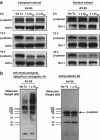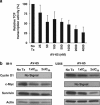AV-65, a novel Wnt/β-catenin signal inhibitor, successfully suppresses progression of multiple myeloma in a mouse model
- PMID: 22829079
- PMCID: PMC3256754
- DOI: 10.1038/bcj.2011.41
AV-65, a novel Wnt/β-catenin signal inhibitor, successfully suppresses progression of multiple myeloma in a mouse model
Abstract
Multiple myeloma (MM) is a malignant neoplasm of plasma cells. Although new molecular targeting agents against MM have been developed based on the better understanding of the underlying pathogenesis, MM still remains an incurable disease. We previously demonstrated that β-catenin, a downstream effector in the Wnt pathway, is a potential target in MM using RNA interference in an in vivo experimental mouse model. In this study, we have screened a library of more than 100 000 small-molecule chemical compounds for novel Wnt/β-catenin signaling inhibitors using a high-throughput transcriptional screening technology. We identified AV-65, which diminished β-catenin protein levels and T-cell factor transcriptional activity. AV-65 then decreased c-myc, cyclin D1 and survivin expression, resulting in the inhibition of MM cell proliferation through the apoptotic pathway. AV-65 treatment prolonged the survival of MM-bearing mice. These findings indicate that this compound represents a novel and attractive therapeutic agent against MM. This study also illustrates the potential of high-throughput transcriptional screening to identify candidates for anticancer drug discovery.
Figures






Similar articles
-
Polyphyllin I induces cell cycle arrest and apoptosis in human myeloma cells via modulating β-catenin signaling pathway.Eur J Haematol. 2016 Oct;97(4):371-8. doi: 10.1111/ejh.12741. Epub 2016 Mar 18. Eur J Haematol. 2016. PMID: 26821882
-
Synergistic Efficacy of the Demethylation Agent Decitabine in Combination With the Protease Inhibitor Bortezomib for Treating Multiple Myeloma Through the Wnt/β-Catenin Pathway.Oncol Res. 2019 Jun 21;27(6):729-737. doi: 10.3727/096504018X15443011011637. Epub 2019 Mar 5. Oncol Res. 2019. PMID: 30837032 Free PMC article.
-
Discovery of Novel Inhibitor for WNT/β-Catenin Pathway by Tankyrase 1/2 Structure-Based Virtual Screening.Molecules. 2020 Apr 6;25(7):1680. doi: 10.3390/molecules25071680. Molecules. 2020. PMID: 32268564 Free PMC article.
-
Discovery of small molecule inhibitors of the Wnt/β-catenin signaling pathway by targeting β-catenin/Tcf4 interactions.Exp Biol Med (Maywood). 2017 Jun;242(11):1185-1197. doi: 10.1177/1535370217708198. Epub 2017 May 5. Exp Biol Med (Maywood). 2017. PMID: 28474989 Free PMC article. Review.
-
[Screening for Chemical Suppressors of the Wnt/β-catenin Signaling Pathway].Yakugaku Zasshi. 2017;137(2):133-136. doi: 10.1248/yakushi.16-00229-2. Yakugaku Zasshi. 2017. PMID: 28154320 Review. Japanese.
Cited by
-
Modulation of post-translational modifications in β-catenin and LRP6 inhibits Wnt signaling pathway in pancreatic cancer.Cancer Lett. 2017 Mar 1;388:64-72. doi: 10.1016/j.canlet.2016.11.026. Epub 2016 Dec 3. Cancer Lett. 2017. PMID: 27919787 Free PMC article.
-
High expression of endoplasmic reticulum chaperone grp94 is a novel molecular hallmark of malignant plasma cells in multiple myeloma.J Hematol Oncol. 2015 Jun 25;8:77. doi: 10.1186/s13045-015-0177-6. J Hematol Oncol. 2015. PMID: 26108343 Free PMC article.
-
Fact or fiction--identifying the elusive multiple myeloma stem cell.J Hematol Oncol. 2013 Dec 7;6:91. doi: 10.1186/1756-8722-6-91. J Hematol Oncol. 2013. PMID: 24314019 Free PMC article. Review.
-
Non-small-cell lung cancer: molecular targeted therapy and personalized medicine - drug resistance, mechanisms, and strategies.Pharmgenomics Pers Med. 2013 Apr 4;6:25-36. doi: 10.2147/PGPM.S26058. Print 2013. Pharmgenomics Pers Med. 2013. PMID: 23690695 Free PMC article.
-
Exosome-mediated delivery of siRNA molecules in cancer therapy: triumphs and challenges.Front Mol Biosci. 2024 Sep 17;11:1447953. doi: 10.3389/fmolb.2024.1447953. eCollection 2024. Front Mol Biosci. 2024. PMID: 39355533 Free PMC article. Review.
References
-
- Kuehl WM, Bergsagel PL. Multiple myeloma: evolving genetic events and host interactions. Nat Rev Cancer. 2002;2:175–187. - PubMed
-
- Harousseau JL, Moreau P. Autologous hematopoietic stem-cell transplantation for multiple myeloma. N Engl J Med. 2009;360:2645–2654. - PubMed
-
- Moreau P, Hullin C, Garban F, Yakoub-Agha I, Benboubker L, Attal M, et al. Tandem autologous stem cell transplantation in high-risk de novo multiple myeloma: final results of the prospective and randomized IFM 99-04 protocol. Blood. 2006;107:397–403. - PubMed
-
- Rosinol L, Perez-Simon JA, Sureda A, de la Rubia J, de Arriba F, Lahuerta JJ, et al. A prospective PETHEMA study of tandem autologous transplantation versus autograft followed by reduced-intensity conditioning allogeneic transplantation in newly diagnosed multiple myeloma. Blood. 2008;112:3591–3593. - PubMed
-
- Bringhen S, Avonto I, Magarotto V, Boccadoro M, Palumbo A. Investigational treatments for multiple myeloma. Expert Opin Investig Drugs. 2006;15:1565–1582. - PubMed
LinkOut - more resources
Full Text Sources
Other Literature Sources
Research Materials

